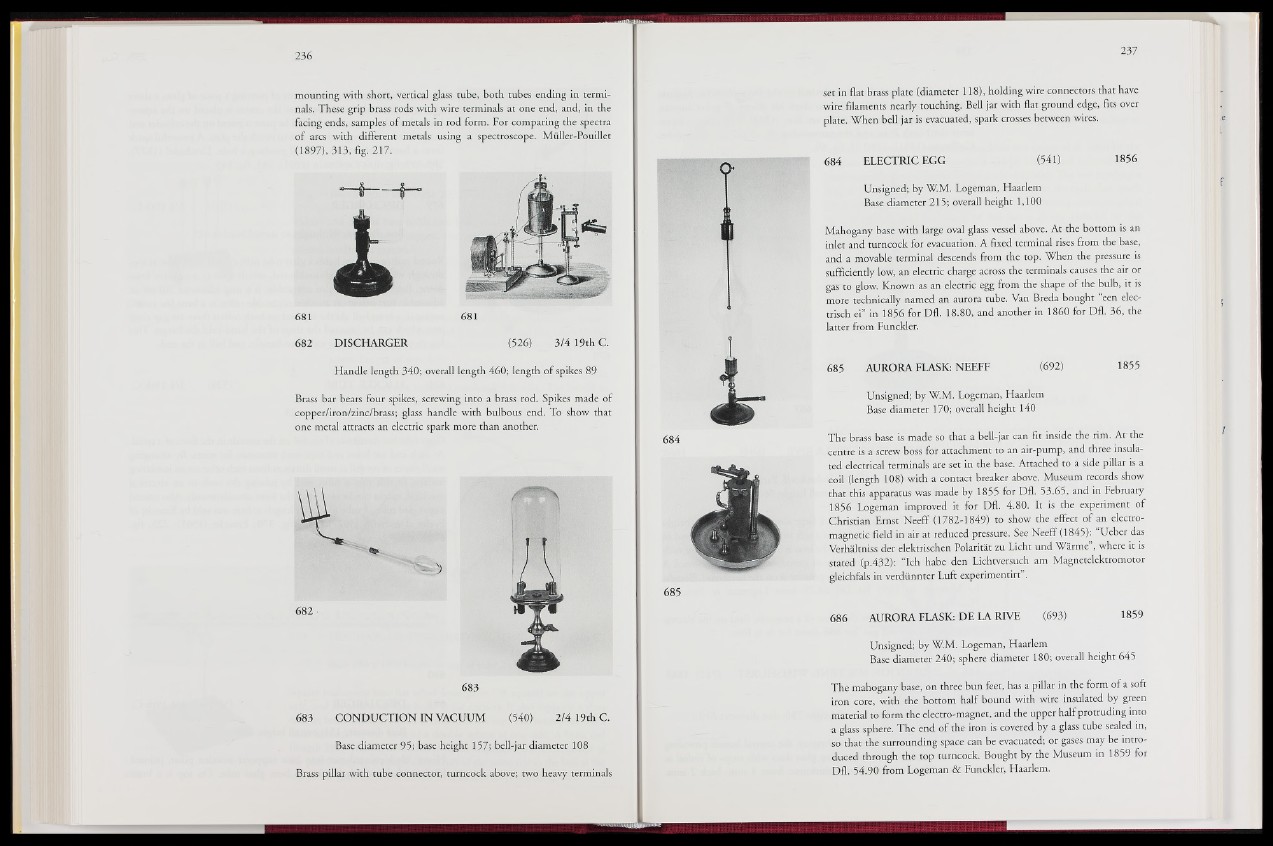
mounting with short, vertical glass tube, both tubes ending in terminals.
These grip brass rods with wire terminals at one end, and, in the
facing ends, samples of metals in rod form. For comparing the spectra
of arcs with different metals using a spectroscope. Miiller-Pouillet
(1897), 313, fig. 217.
681
682 DISCHARGER (526) 3/4 19th C.
Handle length 340; overall length 460; length of spikes 89
Brass bar bears four spikes, screwing into a brass rod. Spikes made of
copper/iron/zinc/brass; glass handle with bulbous end. To show that
one metal attracts an electric spark more than another.
682 •
683
683 CONDUCTION IN VACUUM (540) 2/4 19th C.
Base diameter 95; base height 157; bell-jar diameter 108
Brass pillar with tube connector, turncock above; two heavy terminals
O
i A- 684
set in flat brass plate (diameter 118), holding wire connectors that have
wire filaments nearly touching. Bell jar with flat ground edge, fits over
plate. When bell jar is evacuated, spark crosses between wires.
684 ELECTRIC EGG (541) 1856
Unsigned; by W.M. Logeman, Haarlem
Base diameter 215; overall height 1,100
Mahogany base with large oval glass vessel above. At the bottom is an
inlet and turncock for evacuation. A fixed terminal rises from the base,
and a movable terminal descends from the top. When the pressure is
sufficiently low, an electric charge across the terminals causes the air or
gas to glow. Known as an electric egg from the shape of the bulb, it is
more technically named an aurora tube. Van Breda bought een elec-
trisch ei” in 1856 for Dfl. 18.80, and another in 1860 for Dfl, 36, the
latter from Funckler.
685 AURORA FLASK: NEEFF (692) 1855
Unsigned; by W.M. Logeman, Haarlem
Base diameter 170; overall height 140
The brass base is made so that a bell-jar can fit inside the rim. At’the
centre is a screw boss for attachment to an air-pump, and three insulated
electrical terminals are set in the base. Attached to a side pillar is a
coil (length 108) with a contact breaker above. Museum records show
that this apparatus was made by 1855 for Dfl. 53-65, and in February
1856 Logeman improved it for Dfl. 4.80. li" is the experiment of
Christian Ernst Neefif (1782-1849) to show the effect of an electromagnetic
field in air at reduced pressure. See Neeff (1845): Ueber das
Verhältniss der elektrischen Polarität zu Licht und Wärme , where it is
stated (p.432)B‘Ich habe den Lichtversuch am Magnetelektromotor
gleichfäls in verdünnter Luft experimentirt .
686 AURORA FLASK: DE LA RTVE § ¡6 9 3 )^ 1859
Unsigned; by W.M. Logeman, Haarlem
Base diameter 240; sphere diameter 180; overall height 645
The mahogany base, on three bun feet, has a pillar in the form of a soft
■iron core, with the bottom half bound with wire insulated by green
material to form the electro-magnet, and the upper half protruding into
a glass sphere. The end of the iron is covered by a glass tube sealed in,
so that the surrounding space can be evacuated; or gases may be introduced
through the top turncock. Bought by the Museum in 1859 for
Dfl. 54.90 from Logeman & Funckler, Haarlem.